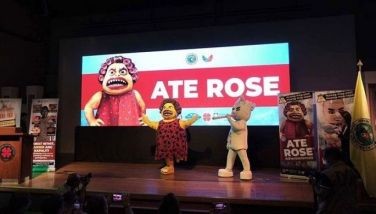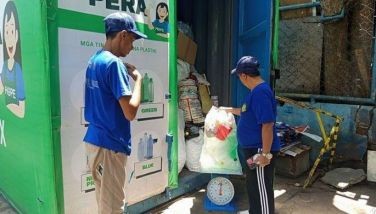Hoops nation

It seems almost a travesty that for a nation steeped in basketball history and proud of its longstanding passion for the game, the Philippines lacks a comprehensive treatise or at least acceptable study on the foibles and intricacies of the national pastime. Now Rafe Bartholomew’s Pacific Rims (Penguin Books 2010) has been around for quite a while, and it so happens that it took a foreigner to do it; not surprising considering Filipinos and Americans have a shared love for the game, which after all was invented in the United States.
Subtitled “Beermen ballin’ in flip-flops and the Philippines’ unlikely love affair with basketball,†Pacific Rims is an absorbing read that any literate basketball fan in the islands should not do without. We get to understand more our craziness for the sport where, as Bartholomew rightly observes, there’s a dirt court in every barrio however far-flung or remote, as ubiquitous as the jeepney or tricycle. The writer too entertains with his easygoing sportswriter’s style, yet not sacrificing substance and clarity for the easy pick and roll most parachute journalists are wont to do.
For starters, the book was written on a fellowship grant that enabled the author to stay in the Philippines for three years, including service as an imbedded reporter with the Alaska Aces nee Milkmen at the height of the team’s rebuilding after the passing of the era of its mid-’90s grand slam squad. The residency with Alaska in fact serves as the main thread of narrative, particularly the team’s campaign in one import laced conference, where Bartholomew hobnobs with the team’s reinforcement Rossel Ellis as well as coach Tim Cone and players Willie Miller during his heyday, Nic Belasco, Jeff Cariaso, Mike Cortez, Poch Juinio, Sonny Thoss, John Ferriols, Dale Singson.
It is investigative sportswriting at its best, especially the tête-à -têtes with Ellis and the afterhours shooting the crap with Mang Tom Urbano, the old Milkmen aide who perpetually gets goosed by cohorts. We get to take a peek inside barong-barongs whose walls are plastered with posters of NBA players, and see the streets where jeepneys have art design with some form of basketball reference, and thus appreciate the game even more.
That it is written from an outsider’s point of view makes it doubly amusing, because many of the points he mentions the locals have come to accept as mundane if not humdrum, the daily dose of basketball lore and ritual. Why yes of course, isn’t that so, now that the author cites it, is often the local reader’s take of precognition.
The book is amply researched, providing much-needed context to Bartholomew, himself an avowed hoops fan in his native New York. Thus we get an inkling of the time he spent in the Ateneo library, poring over old copies of Sportsflash and Champ magazines, referencing the work of long-forgotten sports columnists who may have since moved to the proverbial greener pastures if not gone outright to pasture.
His chapter on the black superman Billy Ray Bates could not have been more timely, as the brilliant eccentric import was in town recently trying to resuscitate a jaded, faded career to be some kind of consultant/trainer in the minor leagues, however in atypical style only to find himself wrestling with old demons. Bartholomew’s astute observations on Bates and his contemporary Norman Black as the yin and yang of PBA imports in the early ’80s bears corresponding analysis, especially how their career paths took opposite directions after their respective retirements from the hardcourt. The chapter also got us rewatching the old Crispa-Great Taste games over Xtreme sports channel, with the late Joe Cantada lording it over the commentary in trademark hyperboles.
Then there are the subplots galore, such as the author participating in a pickup provincial tournament in Boracay as one of the imports, and his also covering a traveling troupe of entertainers featuring unanos versus badings basketball games, or dwarves taking on gays in a riot of a game, which strangely enough is a staple in some town fiestas. Not to mention Bartholomew’s guesting in a teleserye episode, and his immersion in Philippine contemporary culture is complete. Even the minor characters are compassionately portrayed, because the visitor had long traded in his parachute for a playing jersey at a local tailoring shop.
But as mentioned, it is his time with Alaska that is the main pivot, and we practically get to be in the same locker room as the exhibitionist Miller and the sublimely farting Juinio, and join the fracas as well when the rest of the Aces cheer their in-house reporter on with his newly-coined nickname worthy of great and grimy Philippine dugouts: Chupa-eng! Chupa-eng!
Even the Philippine predilection for lookalikes is sufficiently chronicled, with Bartholomew making humorous capital out of his alleged resemblance to the former Alaska player John Arigo, to the extent of signing autographs for the locals in out-of-town games. His interview with the Alaska elder Kurt Bachmann is also good for a few laughs, getting down pat the conyo side of things. And his take on then PBL commissioner Chino Trinidad as an energizer Peewee Herman is on the dot.
Little doubt that there were genuine and lasting friendships formed during the author’s stay, and for Alaska to win the import-laced conference just as Bartholomew was covering the team in depth could only make for a perfect storybook ending. If there’s one thing this book has done, it has rekindled an interest in the PBA, the league we grew up with as adolescents in a suburban Diliman village.
It also helps remind us how much the game has changed, and yet the basics remain as rudimentary as ever. The big fundamental! Interesting too would be a follow up reportage on the Alaska team now, because that has also gone through a complete overhaul with coach Cone departed for another team, signaling the end of an era.
Still we can’t get enough of sports journalism or literature, and Pacific Rims whets the appetite even more. Where’s the long-awaited biography of Baby Dalupan by Krip Yuson, or the small novel on Pancho Villa by Recah Trinidad as excerpted in his Inquirer column? What about the Tagalog kwento of the fictional cyclist Pedro Muryoti by Al Mendoza? In a corner of the apartment is a hand-me-down book of Gloria Goloy on the confessions of a sportswriting housewife. These will all fall into the same grab bag as Bartholomew’s loving and compassionate time in our islands of hoops and heroes.




















